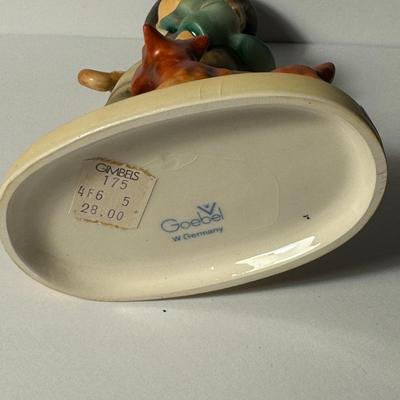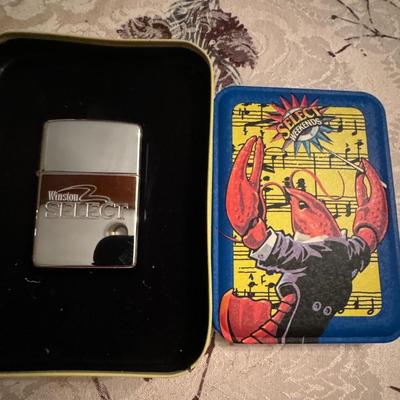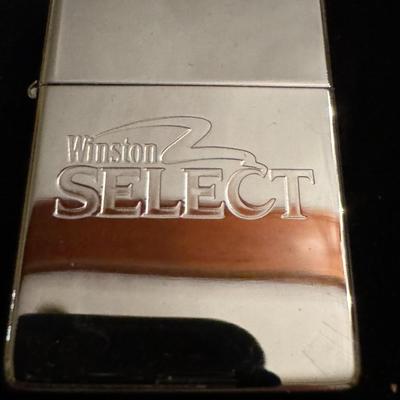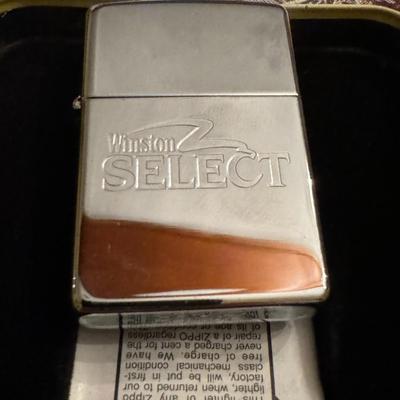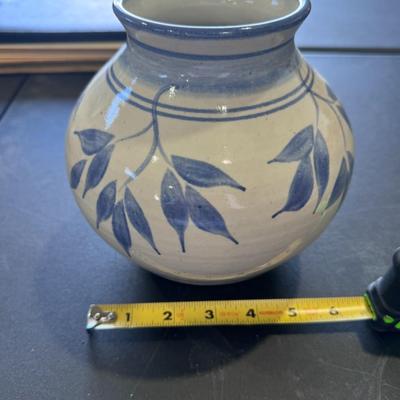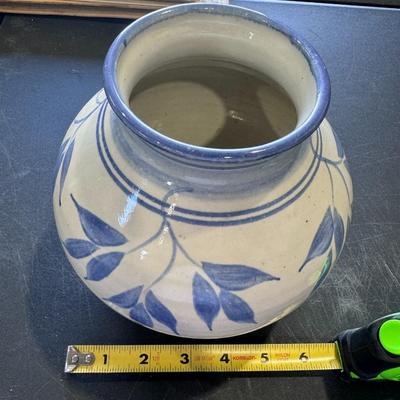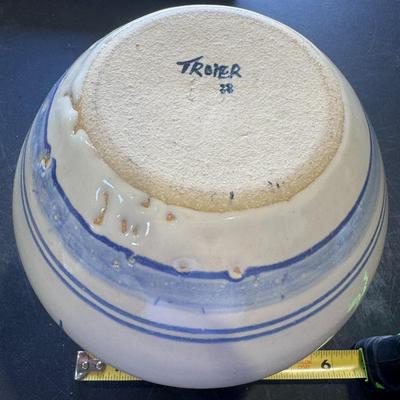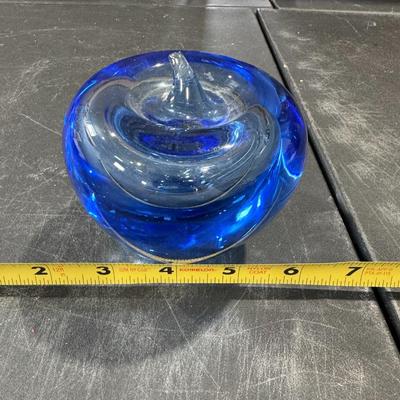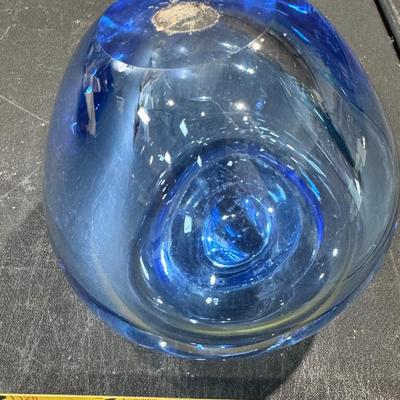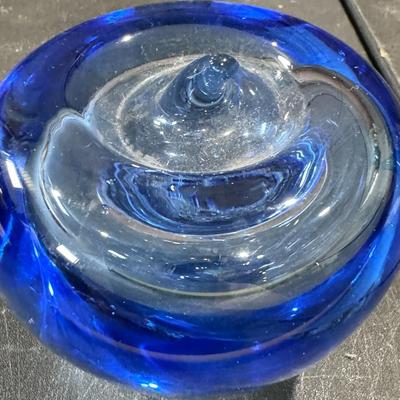-

A Joan Rivers Classics Women's Watch with an orange leather band and a blue dial. It is described as a colorful wrist watch with orange band and numbers and a bright blue face. The watch is water resistant and has a leather band. The watch's dial has orange numerals, and the words "Joan Rivers Classics" and "Quartz" are displayed. The square-shaped case is silver-toned 1305 / 1369 -
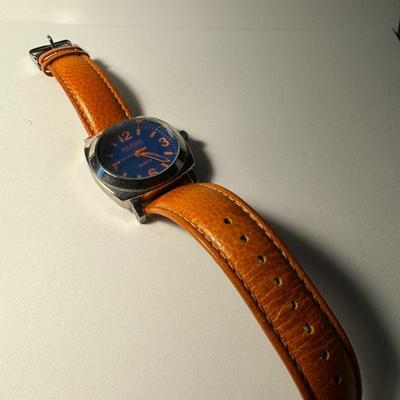
A Joan Rivers Classics Women's Watch with an orange leather band and a blue dial. It is described as a colorful wrist watch with orange band and numbers and a bright blue face. The watch is water resistant and has a leather band. The watch's dial has orange numerals, and the words "Joan Rivers Classics" and "Quartz" are displayed. The square-shaped case is silver-toned 1306 / 1369 -
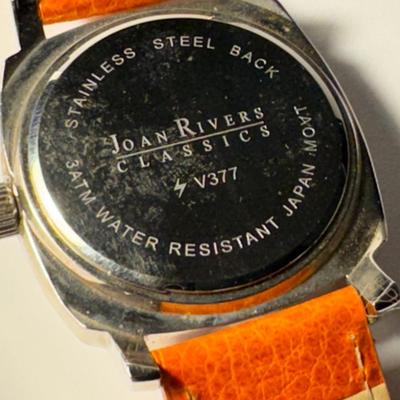
A Joan Rivers Classics Women's Watch with an orange leather band and a blue dial. It is described as a colorful wrist watch with orange band and numbers and a bright blue face. The watch is water resistant and has a leather band. The watch's dial has orange numerals, and the words "Joan Rivers Classics" and "Quartz" are displayed. The square-shaped case is silver-toned 1307 / 1369 -
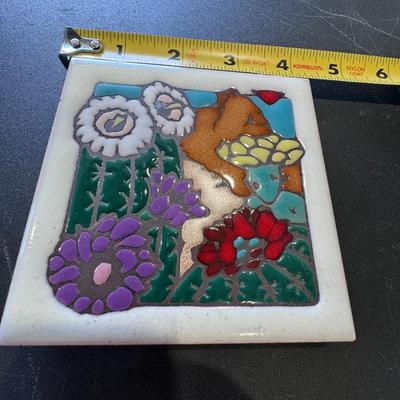
Tile featuring a desert scene, likely inspired by Southwest or Mexican aesthetics. Here's more information about this type of item: Functionality: It can be used as a trivet to protect surfaces from hot dishes or teapots, or as a decorative accent tile to be displayed or even integrated into a backsplash or wall. Design: The specific design in your image showcases cacti and desert flowers, and similar pieces are often described with themes like "Mexican Hats" or "Desert Scene". Craftsmanship: These tiles are typically hand-glazed and kiln-fired, making them durable and often unique due to variations in handcrafting. 1311 / 1369 -
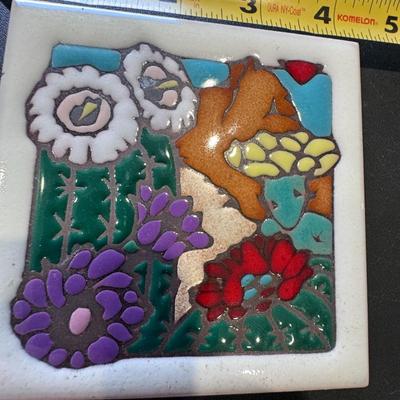
Tile featuring a desert scene, likely inspired by Southwest or Mexican aesthetics. Here's more information about this type of item: Functionality: It can be used as a trivet to protect surfaces from hot dishes or teapots, or as a decorative accent tile to be displayed or even integrated into a backsplash or wall. Design: The specific design in your image showcases cacti and desert flowers, and similar pieces are often described with themes like "Mexican Hats" or "Desert Scene". Craftsmanship: These tiles are typically hand-glazed and kiln-fired, making them durable and often unique due to variations in handcrafting. 1312 / 1369 -
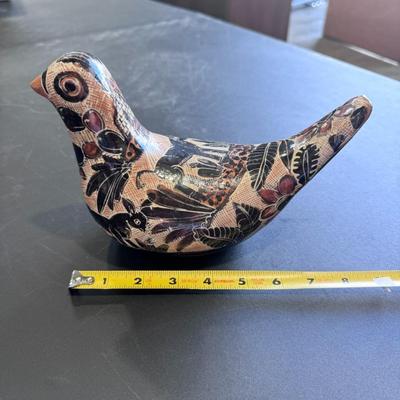
Origin and Craftsmanship: Tonala pottery is known for its burnished or "scented" clay and features traditional Mexican folk art details, often hand-painted with intricate designs. Artistic Style: Common decorative motifs include the nahual (a shapeshifter often depicted as a smiling cat) and the flor de Tonalá, a pattern featuring deep blue blooms, and, as in your image, birds. Historical Context: While Tonala pottery has a long history, pieces like the one in your image, particularly with bolder colors, are often associated with the mid-1970s to mid-1980s when studios incorporated more vibrant hues into their work. 1313 / 1369 -
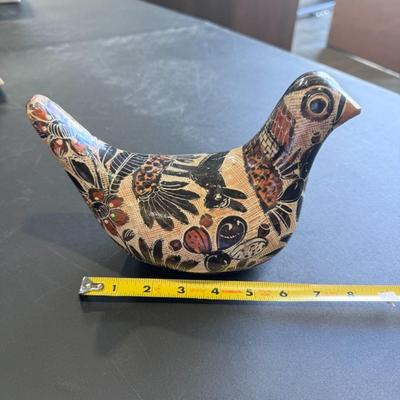
Origin and Craftsmanship: Tonala pottery is known for its burnished or "scented" clay and features traditional Mexican folk art details, often hand-painted with intricate designs. Artistic Style: Common decorative motifs include the nahual (a shapeshifter often depicted as a smiling cat) and the flor de Tonalá, a pattern featuring deep blue blooms, and, as in your image, birds. Historical Context: While Tonala pottery has a long history, pieces like the one in your image, particularly with bolder colors, are often associated with the mid-1970s to mid-1980s when studios incorporated more vibrant hues into their work. 1314 / 1369 -
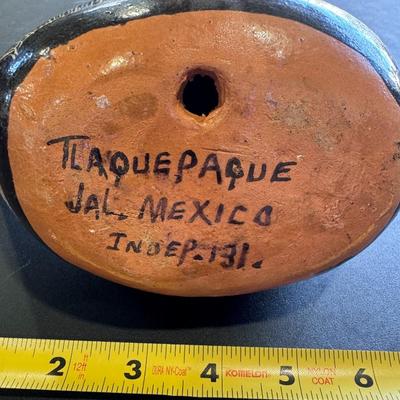
Origin and Craftsmanship: Tonala pottery is known for its burnished or "scented" clay and features traditional Mexican folk art details, often hand-painted with intricate designs. Artistic Style: Common decorative motifs include the nahual (a shapeshifter often depicted as a smiling cat) and the flor de Tonalá, a pattern featuring deep blue blooms, and, as in your image, birds. Historical Context: While Tonala pottery has a long history, pieces like the one in your image, particularly with bolder colors, are often associated with the mid-1970s to mid-1980s when studios incorporated more vibrant hues into their work. 1315 / 1369 -
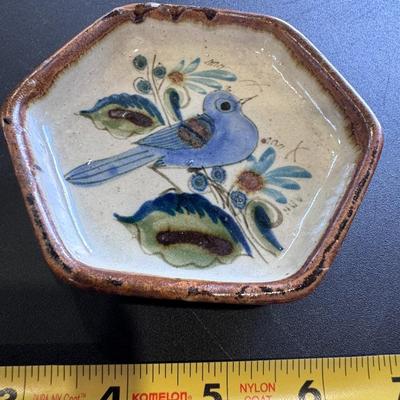
Handcrafted and Unique: Each Ken Edwards piece, including this hexagonal tray, is hand-decorated by skilled artisans, ensuring that no two pieces are exactly alike, making each a unique work of art. Lead-Free Stoneware: The pottery is made from high-temperature stoneware and is certified lead-free, making it safe for use with food and beverages. Durable and Functional: Ken Edwards stoneware is designed for everyday use and is microwave safe, freezer safe, oven safe, and dishwasher safe. Tonala Tradition: The pottery is created in the traditional style of Tonala, a crafts village in Central Mexico known for its ceramics, incorporating motifs like birds, flowers, and other natural elements. 1316 / 1369 -
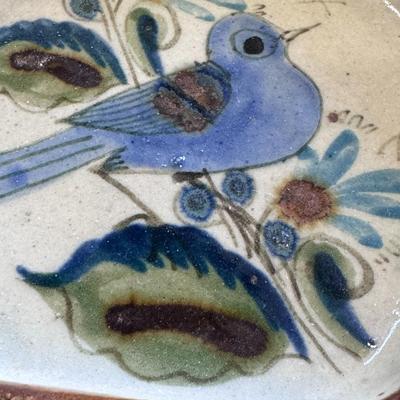
Handcrafted and Unique: Each Ken Edwards piece, including this hexagonal tray, is hand-decorated by skilled artisans, ensuring that no two pieces are exactly alike, making each a unique work of art. Lead-Free Stoneware: The pottery is made from high-temperature stoneware and is certified lead-free, making it safe for use with food and beverages. Durable and Functional: Ken Edwards stoneware is designed for everyday use and is microwave safe, freezer safe, oven safe, and dishwasher safe. Tonala Tradition: The pottery is created in the traditional style of Tonala, a crafts village in Central Mexico known for its ceramics, incorporating motifs like birds, flowers, and other natural elements. 1317 / 1369 -
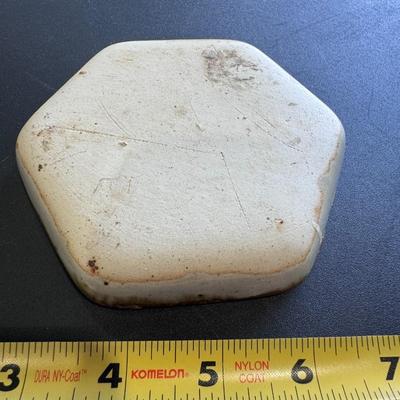
Handcrafted and Unique: Each Ken Edwards piece, including this hexagonal tray, is hand-decorated by skilled artisans, ensuring that no two pieces are exactly alike, making each a unique work of art. Lead-Free Stoneware: The pottery is made from high-temperature stoneware and is certified lead-free, making it safe for use with food and beverages. Durable and Functional: Ken Edwards stoneware is designed for everyday use and is microwave safe, freezer safe, oven safe, and dishwasher safe. Tonala Tradition: The pottery is created in the traditional style of Tonala, a crafts village in Central Mexico known for its ceramics, incorporating motifs like birds, flowers, and other natural elements. 1318 / 1369 -
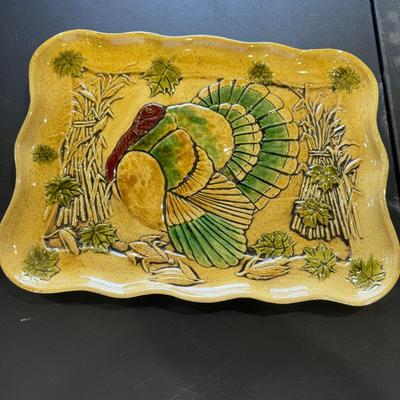
The image shows a vintage studio art pottery turkey platter. These platters are commonly used for serving during Thanksgiving or as decorative items for fall seasonal decor. Here's some information about such platters: Design and Features: They typically feature a central turkey motif, often surrounded by autumn-themed elements like corn stalks, leaves, or other harvest details, and can be hand-painted with vibrant colors. 1319 / 1369 -
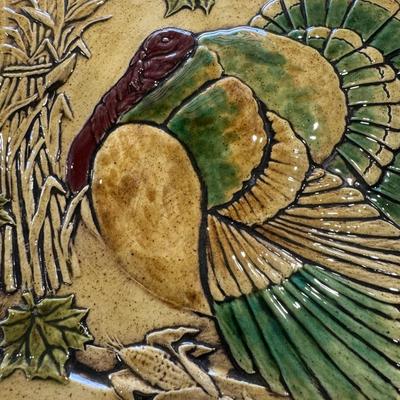
The image shows a vintage studio art pottery turkey platter. These platters are commonly used for serving during Thanksgiving or as decorative items for fall seasonal decor. Here's some information about such platters: Design and Features: They typically feature a central turkey motif, often surrounded by autumn-themed elements like corn stalks, leaves, or other harvest details, and can be hand-painted with vibrant colors. 1320 / 1369 -
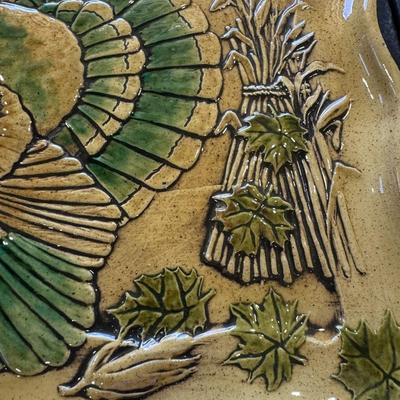
The image shows a vintage studio art pottery turkey platter. These platters are commonly used for serving during Thanksgiving or as decorative items for fall seasonal decor. Here's some information about such platters: Design and Features: They typically feature a central turkey motif, often surrounded by autumn-themed elements like corn stalks, leaves, or other harvest details, and can be hand-painted with vibrant colors. 1321 / 1369 -
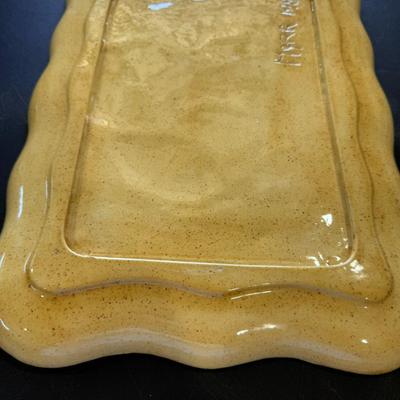
The image shows a vintage studio art pottery turkey platter. These platters are commonly used for serving during Thanksgiving or as decorative items for fall seasonal decor. Here's some information about such platters: Design and Features: They typically feature a central turkey motif, often surrounded by autumn-themed elements like corn stalks, leaves, or other harvest details, and can be hand-painted with vibrant colors. 1322 / 1369 -
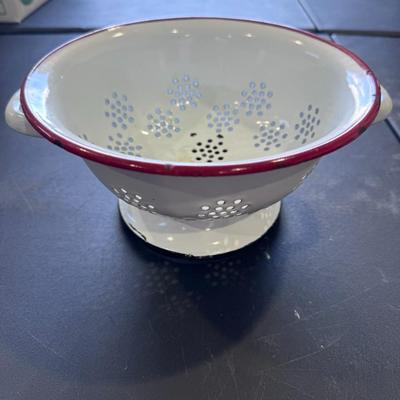
type: Colander/Strainer. Material: Enamelware, often over a base metal like cast iron. Features: Typically has perforations for draining and handles for easy use and handling. Usage: Used in kitchens for tasks such as rinsing fruits and vegetables, draining pasta, or washing other food items. 1323 / 1369 -
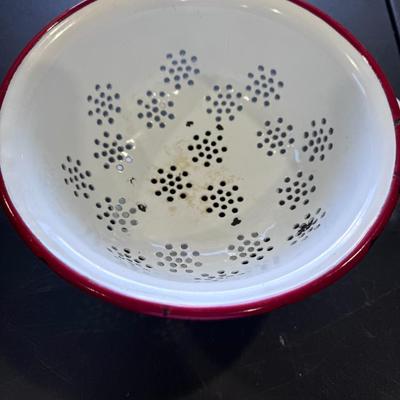
type: Colander/Strainer. Material: Enamelware, often over a base metal like cast iron. Features: Typically has perforations for draining and handles for easy use and handling. Usage: Used in kitchens for tasks such as rinsing fruits and vegetables, draining pasta, or washing other food items. 1324 / 1369 -
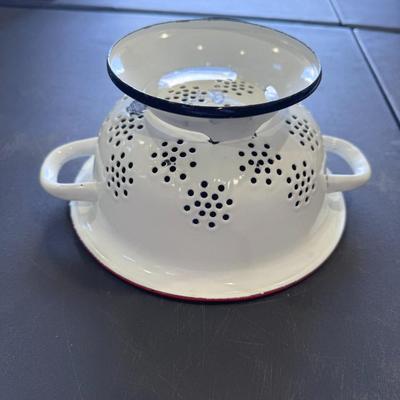
type: Colander/Strainer. Material: Enamelware, often over a base metal like cast iron. Features: Typically has perforations for draining and handles for easy use and handling. Usage: Used in kitchens for tasks such as rinsing fruits and vegetables, draining pasta, or washing other food items. 1325 / 1369 -
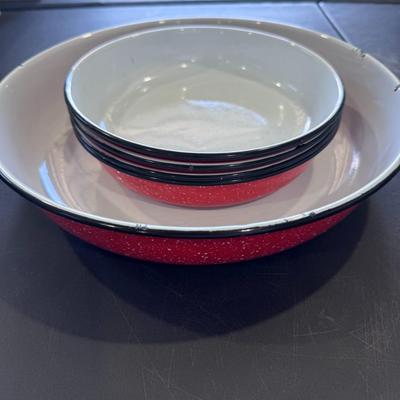
Material: Enamelware is crafted by fusing powdered glass onto a heavy-gauge steel base, providing a durable and smooth surface that resists chemical reactions. Design: These specific bowls feature a classic red speckled or splatter design with a contrasting black rim and a white interior, creating a rustic and vintage aesthetic. Versatility: Enamelware bowls are known for their versatility and can be used for mixing ingredients, serving food, or even for baking and cooking over campfires or stovetops (though not microwave safe). Care: They are typically dishwasher safe for easy cleaning, but it's best to avoid abrasive cleaners and harsh stain removers to maintain the surface. Baked-on food can often be removed by soaking in warm, soapy water and bringing it to a gentle boil with a small amount of liquid laundry detergen 1326 / 1369 -
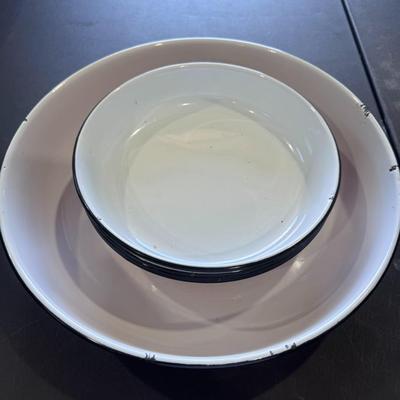
Material: Enamelware is crafted by fusing powdered glass onto a heavy-gauge steel base, providing a durable and smooth surface that resists chemical reactions. Design: These specific bowls feature a classic red speckled or splatter design with a contrasting black rim and a white interior, creating a rustic and vintage aesthetic. Versatility: Enamelware bowls are known for their versatility and can be used for mixing ingredients, serving food, or even for baking and cooking over campfires or stovetops (though not microwave safe). Care: They are typically dishwasher safe for easy cleaning, but it's best to avoid abrasive cleaners and harsh stain removers to maintain the surface. Baked-on food can often be removed by soaking in warm, soapy water and bringing it to a gentle boil with a small amount of liquid laundry detergen 1327 / 1369 -
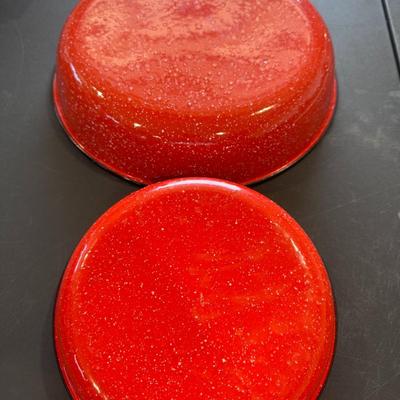
Material: Enamelware is crafted by fusing powdered glass onto a heavy-gauge steel base, providing a durable and smooth surface that resists chemical reactions. Design: These specific bowls feature a classic red speckled or splatter design with a contrasting black rim and a white interior, creating a rustic and vintage aesthetic. Versatility: Enamelware bowls are known for their versatility and can be used for mixing ingredients, serving food, or even for baking and cooking over campfires or stovetops (though not microwave safe). Care: They are typically dishwasher safe for easy cleaning, but it's best to avoid abrasive cleaners and harsh stain removers to maintain the surface. Baked-on food can often be removed by soaking in warm, soapy water and bringing it to a gentle boil with a small amount of liquid laundry detergen 1328 / 1369 -
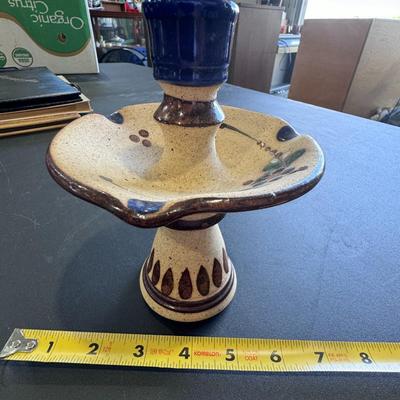
Tonala Mexican Folk Art Pottery Candle Holder, also referred to as a candlestick holder. Here's more information about this type of piece: Origin and Craftsmanship: It is a unique, handmade item from Tonala, Mexico, showcasing traditional Mexican craftsmanship. Design: These candle holders typically feature hand-painted designs, often floral patterns, on a natural clay, sometimes sandstone-like, tiered or pedestalled base. The piece in the image appears to have a matte, rough finish with glossy floral details, and the cup for the candle is a distinct blue color. Condition and Features: As a vintage item, it is typically found in good condition with wear consistent with age and use, though some may exhibit minor chips or crazing. Many pieces are signed by the artist, such as "CAT" or "Ken Edwards". 1329 / 1369 -
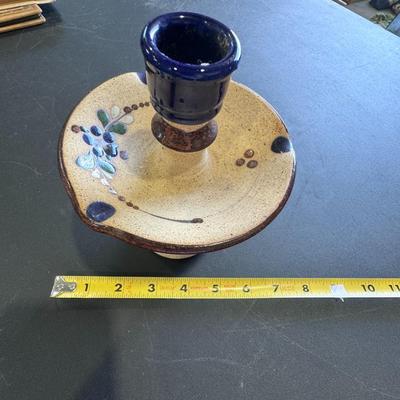
Tonala Mexican Folk Art Pottery Candle Holder, also referred to as a candlestick holder. Here's more information about this type of piece: Origin and Craftsmanship: It is a unique, handmade item from Tonala, Mexico, showcasing traditional Mexican craftsmanship. Design: These candle holders typically feature hand-painted designs, often floral patterns, on a natural clay, sometimes sandstone-like, tiered or pedestalled base. The piece in the image appears to have a matte, rough finish with glossy floral details, and the cup for the candle is a distinct blue color. Condition and Features: As a vintage item, it is typically found in good condition with wear consistent with age and use, though some may exhibit minor chips or crazing. Many pieces are signed by the artist, such as "CAT" or "Ken Edwards". 1330 / 1369 -
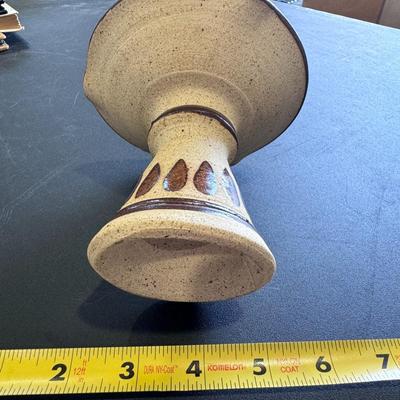
Tonala Mexican Folk Art Pottery Candle Holder, also referred to as a candlestick holder. Here's more information about this type of piece: Origin and Craftsmanship: It is a unique, handmade item from Tonala, Mexico, showcasing traditional Mexican craftsmanship. Design: These candle holders typically feature hand-painted designs, often floral patterns, on a natural clay, sometimes sandstone-like, tiered or pedestalled base. The piece in the image appears to have a matte, rough finish with glossy floral details, and the cup for the candle is a distinct blue color. Condition and Features: As a vintage item, it is typically found in good condition with wear consistent with age and use, though some may exhibit minor chips or crazing. Many pieces are signed by the artist, such as "CAT" or "Ken Edwards". 1331 / 1369 -
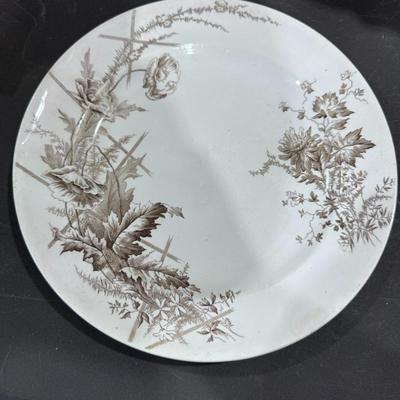
Manufacturer: Burgess & Leigh, later known as Burleigh. Location: Middleport Pottery in Burslem, Stoke-on-Trent, England. Burgess & Leigh moved to Middleport Pottery in 1889, where production continues today. Pattern Name: "Poppy". Registration Number: R^N^o 133743. This registration number dates the specific piece to either 1889 or 1890, according to sources found in the search results. This aligns with the opening of Middleport Pottery in 1889. This mark indicates that the piece is an authentic antique from the late 19th century, featuring the distinctive Poppy pattern from Burgess & Leigh's early period at Middleport Pottery. 1332 / 1369 -
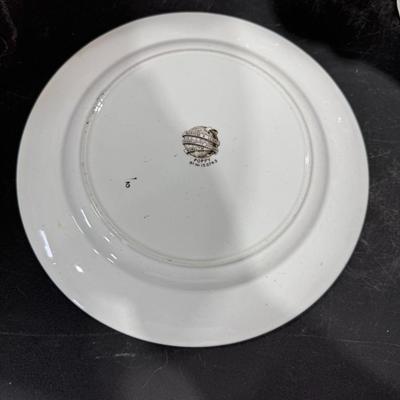
Manufacturer: Burgess & Leigh, later known as Burleigh. Location: Middleport Pottery in Burslem, Stoke-on-Trent, England. Burgess & Leigh moved to Middleport Pottery in 1889, where production continues today. Pattern Name: "Poppy". Registration Number: R^N^o 133743. This registration number dates the specific piece to either 1889 or 1890, according to sources found in the search results. This aligns with the opening of Middleport Pottery in 1889. This mark indicates that the piece is an authentic antique from the late 19th century, featuring the distinctive Poppy pattern from Burgess & Leigh's early period at Middleport Pottery. 1333 / 1369 -
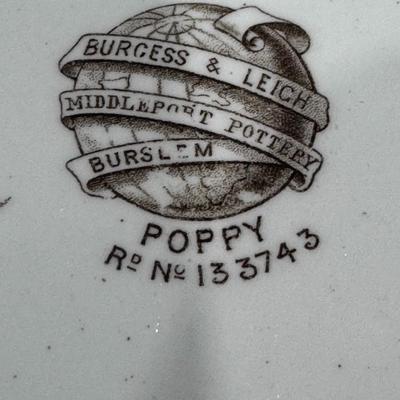
Manufacturer: Burgess & Leigh, later known as Burleigh. Location: Middleport Pottery in Burslem, Stoke-on-Trent, England. Burgess & Leigh moved to Middleport Pottery in 1889, where production continues today. Pattern Name: "Poppy". Registration Number: R^N^o 133743. This registration number dates the specific piece to either 1889 or 1890, according to sources found in the search results. This aligns with the opening of Middleport Pottery in 1889. This mark indicates that the piece is an authentic antique from the late 19th century, featuring the distinctive Poppy pattern from Burgess & Leigh's early period at Middleport Pottery. 1334 / 1369 -
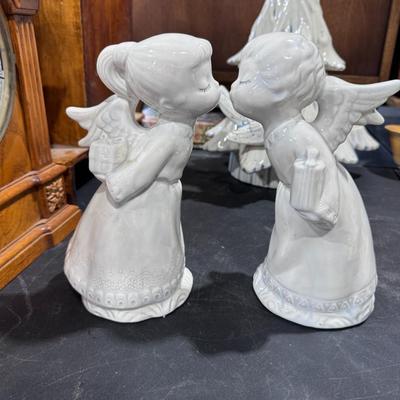
Kissing Angel Figurines, often found as decorative items, particularly popular during the mid-20th century. Here's more information about them: Description: These figurines typically depict a boy and girl angel in a sweet, kissing embrace, often with details like blushed cheeks, pucker lips, and white robes with golden highlights or ceramic "spaghetti" trim. Material and Origin: They are commonly made from porcelain or ceramic bisque, with many vintage examples originating from Japan or Taiwan. Era: Kissing angel figurines, similar to the ones pictured, were highly popular from the 1940s through the 1970s, embodying a sense of love and innocence in home decor. Purpose: These figurines serve as decorative pieces and are particularly cherished by collectors of vintage holiday decor or angel-themed 1335 / 1369 -
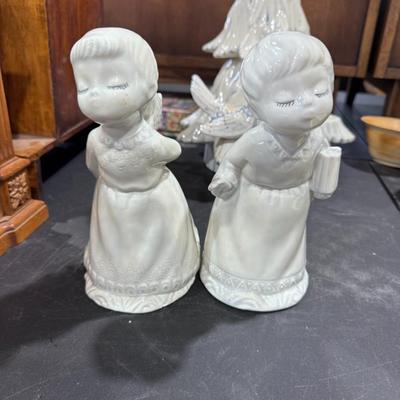
Kissing Angel Figurines, often found as decorative items, particularly popular during the mid-20th century. Here's more information about them: Description: These figurines typically depict a boy and girl angel in a sweet, kissing embrace, often with details like blushed cheeks, pucker lips, and white robes with golden highlights or ceramic "spaghetti" trim. Material and Origin: They are commonly made from porcelain or ceramic bisque, with many vintage examples originating from Japan or Taiwan. Era: Kissing angel figurines, similar to the ones pictured, were highly popular from the 1940s through the 1970s, embodying a sense of love and innocence in home decor. Purpose: These figurines serve as decorative pieces and are particularly cherished by collectors of vintage holiday decor or angel-themed 1336 / 1369 -
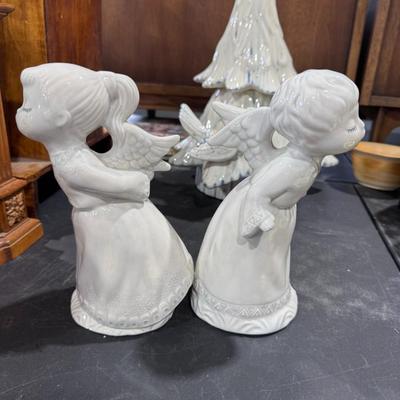
Kissing Angel Figurines, often found as decorative items, particularly popular during the mid-20th century. Here's more information about them: Description: These figurines typically depict a boy and girl angel in a sweet, kissing embrace, often with details like blushed cheeks, pucker lips, and white robes with golden highlights or ceramic "spaghetti" trim. Material and Origin: They are commonly made from porcelain or ceramic bisque, with many vintage examples originating from Japan or Taiwan. Era: Kissing angel figurines, similar to the ones pictured, were highly popular from the 1940s through the 1970s, embodying a sense of love and innocence in home decor. Purpose: These figurines serve as decorative pieces and are particularly cherished by collectors of vintage holiday decor or angel-themed 1337 / 1369 -
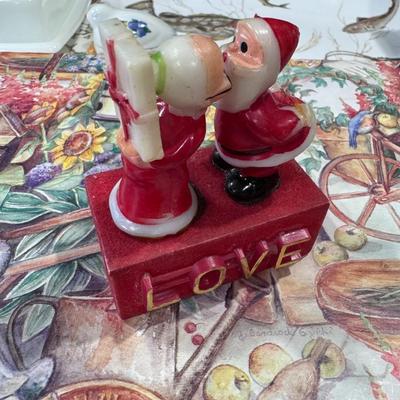
The image shows a vintage Christmas figurine featuring Santa Claus and Mrs. Claus kissing, mounted on a base that spells out "LOVE". This type of collectible is often referred to as a "Vintage Miniature Kissing Santa & Mrs Claus Christmas Figurine". Here are some details about the figurine: Subject: Depicts Santa Claus and Mrs. Claus in a kissing pose. Style/Material: Likely made of hard plastic or ceramic/porcelain, given the era. Base: Features the word "LOVE" on the base, adding to its romantic and sentimental theme. 1338 / 1369 -
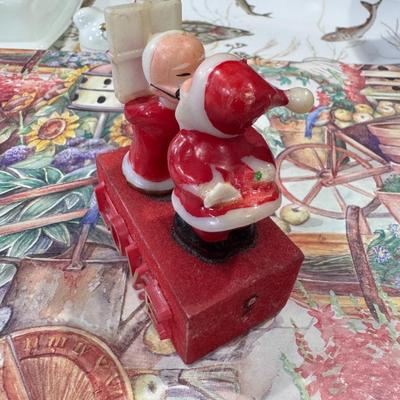
The image shows a vintage Christmas figurine featuring Santa Claus and Mrs. Claus kissing, mounted on a base that spells out "LOVE". This type of collectible is often referred to as a "Vintage Miniature Kissing Santa & Mrs Claus Christmas Figurine". Here are some details about the figurine: Subject: Depicts Santa Claus and Mrs. Claus in a kissing pose. Style/Material: Likely made of hard plastic or ceramic/porcelain, given the era. Base: Features the word "LOVE" on the base, adding to its romantic and sentimental theme. 1339 / 1369 -
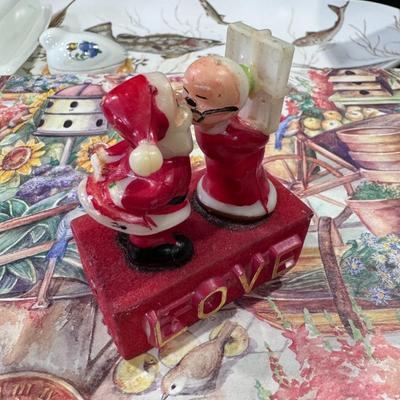
The image shows a vintage Christmas figurine featuring Santa Claus and Mrs. Claus kissing, mounted on a base that spells out "LOVE". This type of collectible is often referred to as a "Vintage Miniature Kissing Santa & Mrs Claus Christmas Figurine". Here are some details about the figurine: Subject: Depicts Santa Claus and Mrs. Claus in a kissing pose. Style/Material: Likely made of hard plastic or ceramic/porcelain, given the era. Base: Features the word "LOVE" on the base, adding to its romantic and sentimental theme. 1340 / 1369 -
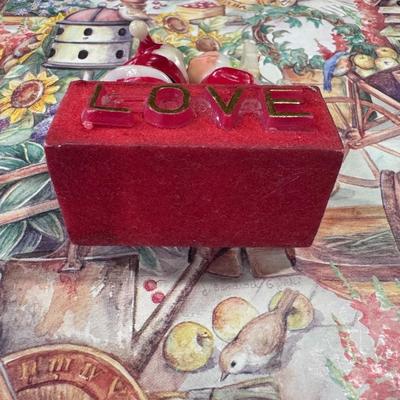
The image shows a vintage Christmas figurine featuring Santa Claus and Mrs. Claus kissing, mounted on a base that spells out "LOVE". This type of collectible is often referred to as a "Vintage Miniature Kissing Santa & Mrs Claus Christmas Figurine". Here are some details about the figurine: Subject: Depicts Santa Claus and Mrs. Claus in a kissing pose. Style/Material: Likely made of hard plastic or ceramic/porcelain, given the era. Base: Features the word "LOVE" on the base, adding to its romantic and sentimental theme. 1341 / 1369 -
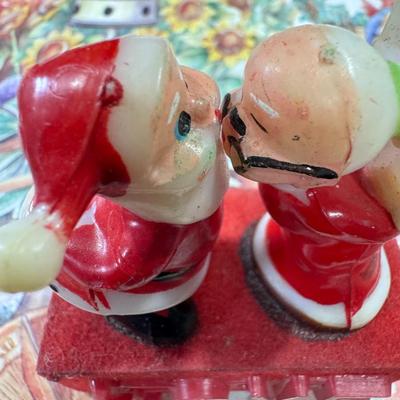
The image shows a vintage Christmas figurine featuring Santa Claus and Mrs. Claus kissing, mounted on a base that spells out "LOVE". This type of collectible is often referred to as a "Vintage Miniature Kissing Santa & Mrs Claus Christmas Figurine". Here are some details about the figurine: Subject: Depicts Santa Claus and Mrs. Claus in a kissing pose. Style/Material: Likely made of hard plastic or ceramic/porcelain, given the era. Base: Features the word "LOVE" on the base, adding to its romantic and sentimental theme. 1342 / 1369 -
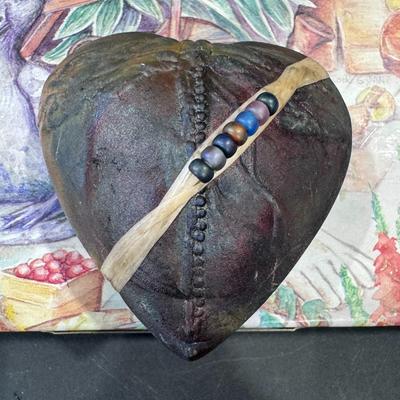
Raku-fired ceramic heart-shaped InnerSpirit Rattle by J. Davis Studio, also commonly referred to as a Spirit Shaker. This handcrafted art piece features: Raku Pottery: The heart is made using the Raku firing technique, a Japanese pottery method where pieces are removed from the kiln while hot and placed in a reduction chamber, creating unique and unpredictable colors and surfaces. Heart Shape & Design: The heart shape is a common motif for these rattles, often associated with promoting specific qualities like resilience, wisdom, or smooth sailing, depending on the specific design and accompanying story card. The one in the image appears to be a "Smooth Sailing" or similar "Smooth Heart" design, characterized by its simpler, unadorned surface compared to other designs featuring motifs like dragonflies or hummingbirds. Beaded Embellishment: A sinew wrap adorned with colorful beads is featured, adding a decorative element and likely contributing to the aesthetic and tactile experience of the rattle. 1343 / 1369 -
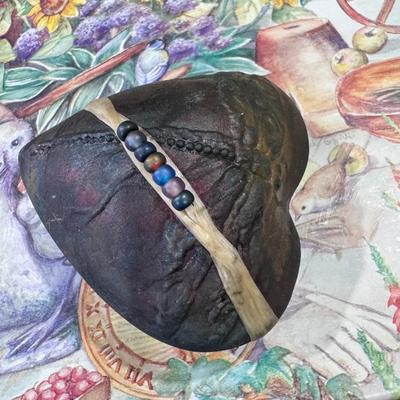
Raku-fired ceramic heart-shaped InnerSpirit Rattle by J. Davis Studio, also commonly referred to as a Spirit Shaker. This handcrafted art piece features: Raku Pottery: The heart is made using the Raku firing technique, a Japanese pottery method where pieces are removed from the kiln while hot and placed in a reduction chamber, creating unique and unpredictable colors and surfaces. Heart Shape & Design: The heart shape is a common motif for these rattles, often associated with promoting specific qualities like resilience, wisdom, or smooth sailing, depending on the specific design and accompanying story card. The one in the image appears to be a "Smooth Sailing" or similar "Smooth Heart" design, characterized by its simpler, unadorned surface compared to other designs featuring motifs like dragonflies or hummingbirds. Beaded Embellishment: A sinew wrap adorned with colorful beads is featured, adding a decorative element and likely contributing to the aesthetic and tactile experience of the rattle. 1344 / 1369 -
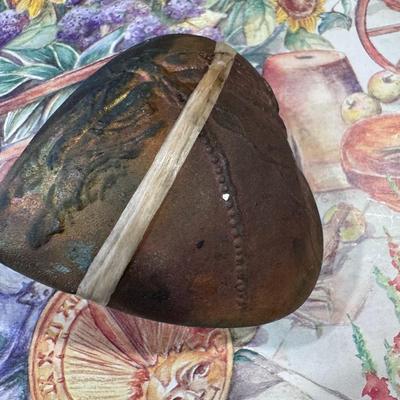
Raku-fired ceramic heart-shaped InnerSpirit Rattle by J. Davis Studio, also commonly referred to as a Spirit Shaker. This handcrafted art piece features: Raku Pottery: The heart is made using the Raku firing technique, a Japanese pottery method where pieces are removed from the kiln while hot and placed in a reduction chamber, creating unique and unpredictable colors and surfaces. Heart Shape & Design: The heart shape is a common motif for these rattles, often associated with promoting specific qualities like resilience, wisdom, or smooth sailing, depending on the specific design and accompanying story card. The one in the image appears to be a "Smooth Sailing" or similar "Smooth Heart" design, characterized by its simpler, unadorned surface compared to other designs featuring motifs like dragonflies or hummingbirds. Beaded Embellishment: A sinew wrap adorned with colorful beads is featured, adding a decorative element and likely contributing to the aesthetic and tactile experience of the rattle. 1345 / 1369 -
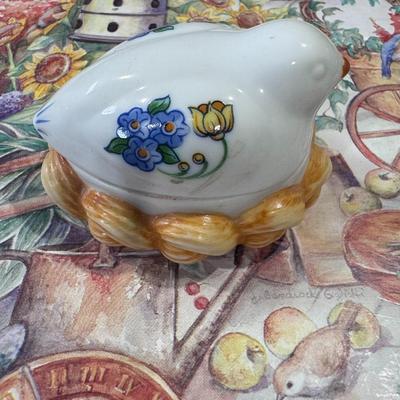
Roma Al Fresco Elizabeth Arden Chick on a Nest Floral Ceramic Lidded Ring Dish, also often referred to as a trinket box or candle box. Here's more information about it: Origin: This piece was made in Japan exclusively for Elizabeth Arden, a well-known beauty brand. Design: It features a charming white ceramic bird with colorful floral patterns (typically blue and yellow flowers) perched on a nest-shaped base. The bird forms the lid of the dish. Purpose: While often described as a ring dish due to its size and shape, it's also commonly used as a trinket box for storing small keepsakes, jewelry, or other treasures. Some versions originally contained a scented candle, making it function as a decorative candle box as well. 1346 / 1369 -
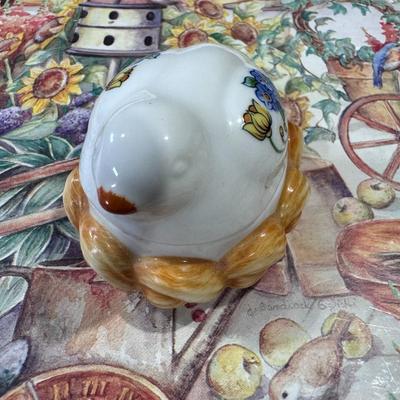
Roma Al Fresco Elizabeth Arden Chick on a Nest Floral Ceramic Lidded Ring Dish, also often referred to as a trinket box or candle box. Here's more information about it: Origin: This piece was made in Japan exclusively for Elizabeth Arden, a well-known beauty brand. Design: It features a charming white ceramic bird with colorful floral patterns (typically blue and yellow flowers) perched on a nest-shaped base. The bird forms the lid of the dish. Purpose: While often described as a ring dish due to its size and shape, it's also commonly used as a trinket box for storing small keepsakes, jewelry, or other treasures. Some versions originally contained a scented candle, making it function as a decorative candle box as well. 1347 / 1369 -
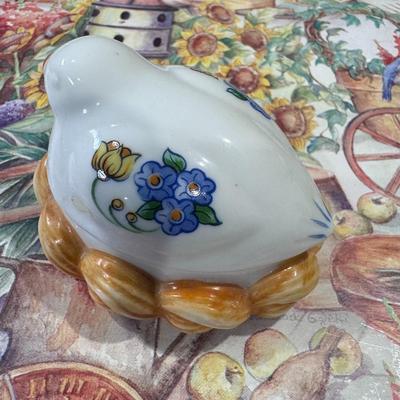
Roma Al Fresco Elizabeth Arden Chick on a Nest Floral Ceramic Lidded Ring Dish, also often referred to as a trinket box or candle box. Here's more information about it: Origin: This piece was made in Japan exclusively for Elizabeth Arden, a well-known beauty brand. Design: It features a charming white ceramic bird with colorful floral patterns (typically blue and yellow flowers) perched on a nest-shaped base. The bird forms the lid of the dish. Purpose: While often described as a ring dish due to its size and shape, it's also commonly used as a trinket box for storing small keepsakes, jewelry, or other treasures. Some versions originally contained a scented candle, making it function as a decorative candle box as well. 1348 / 1369 -
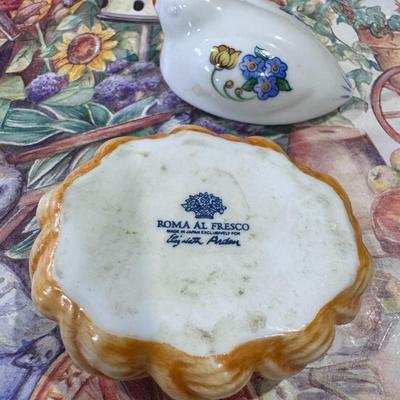
Roma Al Fresco Elizabeth Arden Chick on a Nest Floral Ceramic Lidded Ring Dish, also often referred to as a trinket box or candle box. Here's more information about it: Origin: This piece was made in Japan exclusively for Elizabeth Arden, a well-known beauty brand. Design: It features a charming white ceramic bird with colorful floral patterns (typically blue and yellow flowers) perched on a nest-shaped base. The bird forms the lid of the dish. Purpose: While often described as a ring dish due to its size and shape, it's also commonly used as a trinket box for storing small keepsakes, jewelry, or other treasures. Some versions originally contained a scented candle, making it function as a decorative candle box as well. 1349 / 1369 -
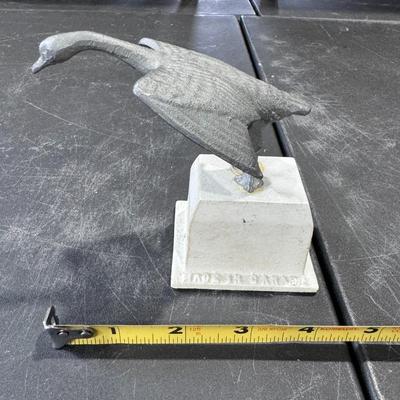
Nice metal goose in flight on stand 1350 / 1369 -
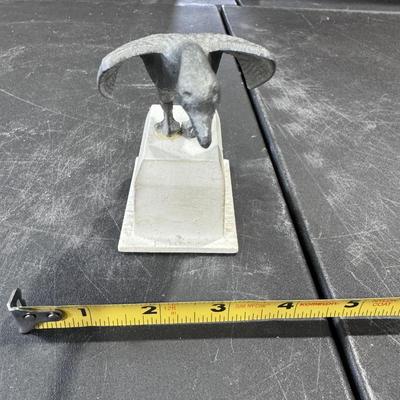
Nice metal goose in flight on stand 1351 / 1369 -
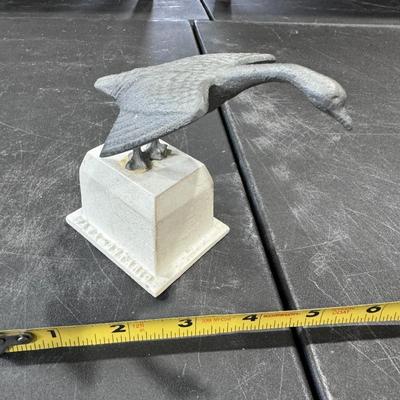
Nice metal goose in flight on stand 1352 / 1369 -
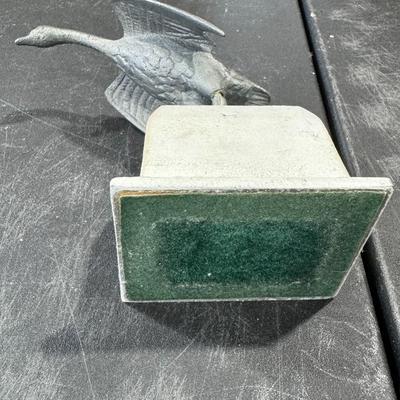
Nice metal goose in flight on stand 1353 / 1369 -
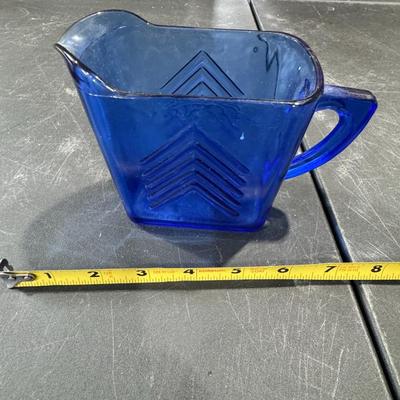
Manufacturer & Origin: It was made by the Hazel Atlas Glass Company, a major American glass manufacturer during the early to mid-20th century. Era: This creamer is a piece of "Depression Glass," which was mass-produced inexpensively in the United States during the 1920s and 1930s, often given as premiums or sold at low prices to boost sales during the Great Depression. Design & Color: It features a distinctive Art Deco chevron (arrow) pattern and is made of vibrant cobalt blue glass. The blue color was one of several popular hues for Depression Glass, including pink, green, yellow, and clear. 1354 / 1369 -
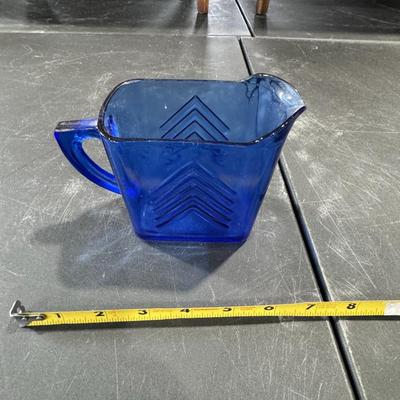
Manufacturer & Origin: It was made by the Hazel Atlas Glass Company, a major American glass manufacturer during the early to mid-20th century. Era: This creamer is a piece of "Depression Glass," which was mass-produced inexpensively in the United States during the 1920s and 1930s, often given as premiums or sold at low prices to boost sales during the Great Depression. Design & Color: It features a distinctive Art Deco chevron (arrow) pattern and is made of vibrant cobalt blue glass. The blue color was one of several popular hues for Depression Glass, including pink, green, yellow, and clear. 1355 / 1369 -
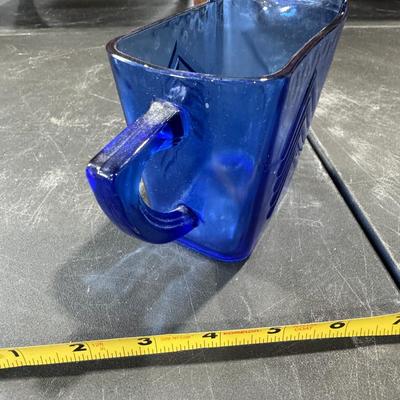
Manufacturer & Origin: It was made by the Hazel Atlas Glass Company, a major American glass manufacturer during the early to mid-20th century. Era: This creamer is a piece of "Depression Glass," which was mass-produced inexpensively in the United States during the 1920s and 1930s, often given as premiums or sold at low prices to boost sales during the Great Depression. Design & Color: It features a distinctive Art Deco chevron (arrow) pattern and is made of vibrant cobalt blue glass. The blue color was one of several popular hues for Depression Glass, including pink, green, yellow, and clear. 1356 / 1369 -
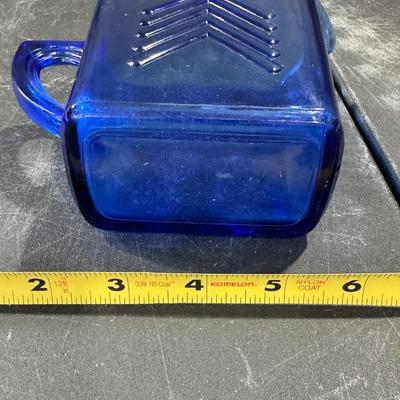
Manufacturer & Origin: It was made by the Hazel Atlas Glass Company, a major American glass manufacturer during the early to mid-20th century. Era: This creamer is a piece of "Depression Glass," which was mass-produced inexpensively in the United States during the 1920s and 1930s, often given as premiums or sold at low prices to boost sales during the Great Depression. Design & Color: It features a distinctive Art Deco chevron (arrow) pattern and is made of vibrant cobalt blue glass. The blue color was one of several popular hues for Depression Glass, including pink, green, yellow, and clear. 1357 / 1369 -
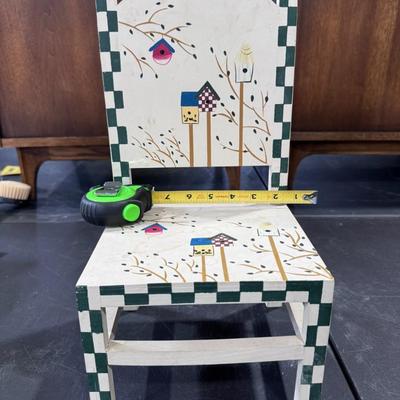
The image shows a decorative folk art chair, likely intended for display or as part of a larger folk art collection, such as alongside a doll like "The Bird Lady". The chair is hand-painted with a distinctive motif of birdhouses and branches, set against a white background with a green and white checkerboard pattern on the legs and backrest. Key details about the chair: Style: Folk Art, characterized by its handmade and often whimsical aesthetic. Decoration: Features hand-painted birdhouses on branches and a checkerboard pattern in green and white. Material: Appears to be made of wood. Purpose: Likely serves as a decorative item or a display piece, potentially associated with larger folk art dolls or figures. Size indication: A measuring tape is present on the seat, suggesting a small size, possibly around 15 inches tall if similar to the chair described with "The Bird Lady" doll. AI responses may include mistakes. Learn more 1361 / 1369 -
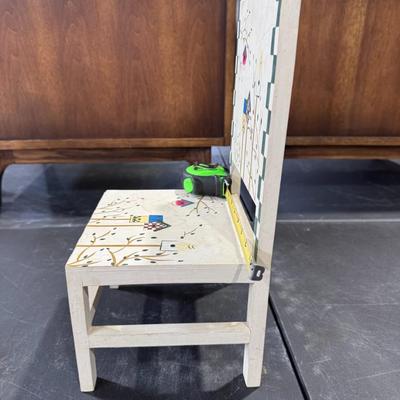
The image shows a decorative folk art chair, likely intended for display or as part of a larger folk art collection, such as alongside a doll like "The Bird Lady". The chair is hand-painted with a distinctive motif of birdhouses and branches, set against a white background with a green and white checkerboard pattern on the legs and backrest. Key details about the chair: Style: Folk Art, characterized by its handmade and often whimsical aesthetic. Decoration: Features hand-painted birdhouses on branches and a checkerboard pattern in green and white. Material: Appears to be made of wood. Purpose: Likely serves as a decorative item or a display piece, potentially associated with larger folk art dolls or figures. Size indication: A measuring tape is present on the seat, suggesting a small size, possibly around 15 inches tall if similar to the chair described with "The Bird Lady" doll. AI responses may include mistakes. Learn more 1362 / 1369 -
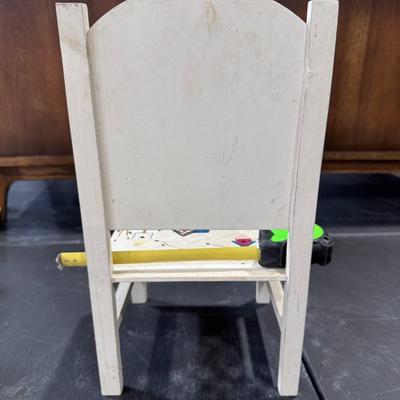
The image shows a decorative folk art chair, likely intended for display or as part of a larger folk art collection, such as alongside a doll like "The Bird Lady". The chair is hand-painted with a distinctive motif of birdhouses and branches, set against a white background with a green and white checkerboard pattern on the legs and backrest. Key details about the chair: Style: Folk Art, characterized by its handmade and often whimsical aesthetic. Decoration: Features hand-painted birdhouses on branches and a checkerboard pattern in green and white. Material: Appears to be made of wood. Purpose: Likely serves as a decorative item or a display piece, potentially associated with larger folk art dolls or figures. Size indication: A measuring tape is present on the seat, suggesting a small size, possibly around 15 inches tall if similar to the chair described with "The Bird Lady" doll. AI responses may include mistakes. Learn more 1363 / 1369 -
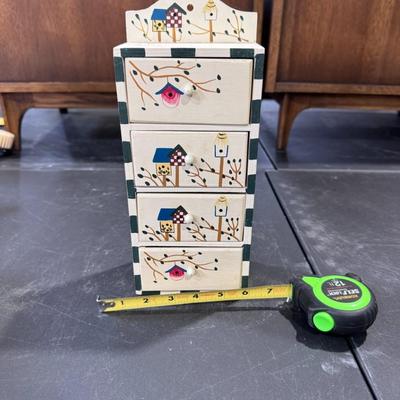
decorative wooden cabinet or jewelry box featuring a hand-painted birdhouse and bird design. It appears to be a multi-drawer storage piece, possibly for small items like jewelry, trinkets, or tea bags. Here's more information about this type of item: Design & Style: It features a "birdhouse design" and is hand-painted with bird and floral motifs, giving it a whimsical, rustic, or cottage-core aesthetic. Functionality: The drawers suggest it's designed for storage and organization of small belongings like jewelry, accessories, or keepsakes. Similar Items & Availability: Similar hand-painted birdhouse-themed storage items, including cabinets and jewelry boxes, can be found on platforms like Etsy and eBay. Measurements: The visible tape measure indicates the object is relatively small, likely designed for tabletop or countertop use, as confirmed by descriptions of similar items around 9" tall x 4.5" wide x 3" deep. 1364 / 1369 -
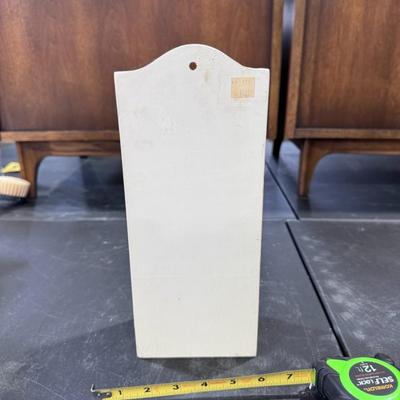
decorative wooden cabinet or jewelry box featuring a hand-painted birdhouse and bird design. It appears to be a multi-drawer storage piece, possibly for small items like jewelry, trinkets, or tea bags. Here's more information about this type of item: Design & Style: It features a "birdhouse design" and is hand-painted with bird and floral motifs, giving it a whimsical, rustic, or cottage-core aesthetic. Functionality: The drawers suggest it's designed for storage and organization of small belongings like jewelry, accessories, or keepsakes. Similar Items & Availability: Similar hand-painted birdhouse-themed storage items, including cabinets and jewelry boxes, can be found on platforms like Etsy and eBay. Measurements: The visible tape measure indicates the object is relatively small, likely designed for tabletop or countertop use, as confirmed by descriptions of similar items around 9" tall x 4.5" wide x 3" deep. 1365 / 1369 -
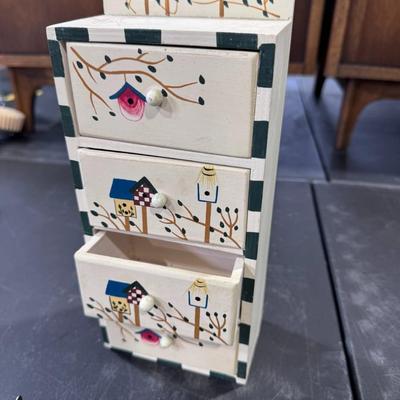
decorative wooden cabinet or jewelry box featuring a hand-painted birdhouse and bird design. It appears to be a multi-drawer storage piece, possibly for small items like jewelry, trinkets, or tea bags. Here's more information about this type of item: Design & Style: It features a "birdhouse design" and is hand-painted with bird and floral motifs, giving it a whimsical, rustic, or cottage-core aesthetic. Functionality: The drawers suggest it's designed for storage and organization of small belongings like jewelry, accessories, or keepsakes. Similar Items & Availability: Similar hand-painted birdhouse-themed storage items, including cabinets and jewelry boxes, can be found on platforms like Etsy and eBay. Measurements: The visible tape measure indicates the object is relatively small, likely designed for tabletop or countertop use, as confirmed by descriptions of similar items around 9" tall x 4.5" wide x 3" deep. 1366 / 1369 -
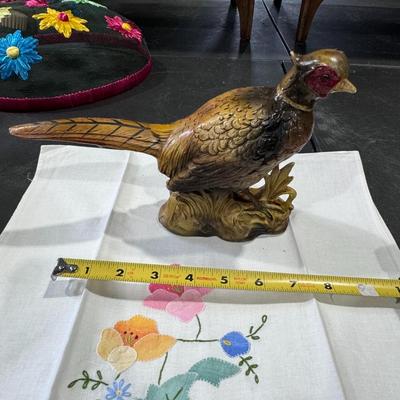
ceramic pheasant figurine, likely from the Mid-Century Modern era, used as a decorative collectible. Here's more information about this type of collectible: Materials and Style These figurines are typically made from ceramic or porcelain and often feature hand-painted details, characteristic of vintage pieces from various manufacturers like Enesco, Holland Mold, or Arnel's. Potential Origin While the exact origin of this specific piece is unknown without manufacturer marks, many such ceramic bird figurines were produced in countries like Japan (e.g., Victoria Ceramics, Arco) during the mid-20th century. 1367 / 1369 -
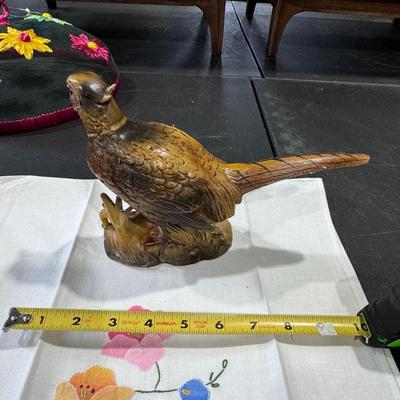
ceramic pheasant figurine, likely from the Mid-Century Modern era, used as a decorative collectible. Here's more information about this type of collectible: Materials and Style These figurines are typically made from ceramic or porcelain and often feature hand-painted details, characteristic of vintage pieces from various manufacturers like Enesco, Holland Mold, or Arnel's. Potential Origin While the exact origin of this specific piece is unknown without manufacturer marks, many such ceramic bird figurines were produced in countries like Japan (e.g., Victoria Ceramics, Arco) during the mid-20th century. 1368 / 1369 -
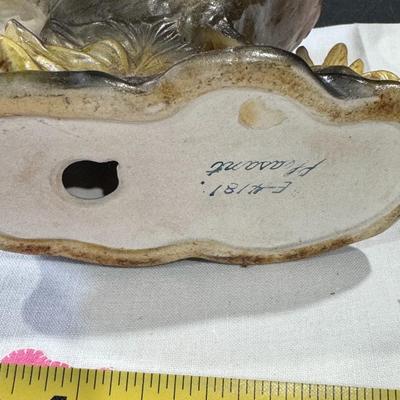
ceramic pheasant figurine, likely from the Mid-Century Modern era, used as a decorative collectible. Here's more information about this type of collectible: Materials and Style These figurines are typically made from ceramic or porcelain and often feature hand-painted details, characteristic of vintage pieces from various manufacturers like Enesco, Holland Mold, or Arnel's. Potential Origin While the exact origin of this specific piece is unknown without manufacturer marks, many such ceramic bird figurines were produced in countries like Japan (e.g., Victoria Ceramics, Arco) during the mid-20th century. 1369 / 1369
Photos 1301 - 1369 of 1369
Per page:
